Ancil McDonald Jackson, Early Texas Ranger…
As with many of my blog stories, current events sometimes take me down an unexpected road. This time it was an inquiry from one of my Jackson blog followers who wanted me to see if I could get a “Ranger Cross” for Ancil’s grave in the Stockdale City Cemetery. I thought that would be a wonderful idea to commemorate this very early Wilson County citizen for his service to his community.
 The Ranger Cross is provided by the Former Texas Ranger Association through a grant from the Texas Historical Society to keep alive the memory of the Rangers who have gone before and to fulfill a mission to create landmarks relating to Texas Ranger History.
The Ranger Cross is provided by the Former Texas Ranger Association through a grant from the Texas Historical Society to keep alive the memory of the Rangers who have gone before and to fulfill a mission to create landmarks relating to Texas Ranger History.
So why do we want a Texas Ranger Cross for Ancil McDonald Jackson? Let’s have a look back in time to those years when Ancil came to Texas with his father and his siblings and the evolution of the Texas Rangers.
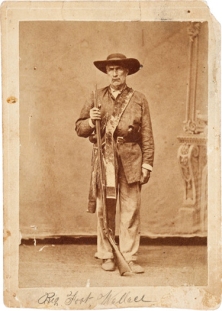 The first Texas Rangers were hired in 1823 only two years after American colonization of Texas had begun by Stephen F. Austin for a punitive expedition against a band of Indians. In November 1835, Texas lawmakers initiated a specific force known as the Texas Rangers. They were required to provide their own horse, gun, ammunition, and rations. The organization had a complement of fifty-six men in three companies. The Rangers were generally charged with protecting the new citizens of Texas primarily from the Indians. While the Rangers did not play a large role in the Texas Revolution, they did serve on “escort” duty helping Texas families escape from the Mexicans after the Battle of the Alamo in the “Great Run-Away Scrape”. The first President of the Republic of Texas, Sam Houston, was very partial and sympathetic to the Indians, so the Rangers did not have much of a role until Mirabeau B. Lamar, the second President of the Republic of Texas came into office in 1838. Lamar hated Indians, so things changed for the Rangers. The Congress of the Republic allowed him to recruit eight companies of mounted volunteers and maintain a company of fifty-six Rangers, then a month later to provide for five similar companies in Central and South Texas. Over the next three years the Rangers waged all-out war against the Indians. They fought in the Cherokee War in 1839 in East Texas, the Council House Fight at San Antonio against the Comanches in 1840 and at the Battle of Plum Creek in 1840. By the end of the Lamar administration, the Rangers had undermined if not broken the strength of the most powerful tribes. From 1846 – 1848, the Rangers fought in the American-Mexican War and were famous as being ruthless and lethal. The local Mexicans referred to them as “los diablos Tejanos.”
The first Texas Rangers were hired in 1823 only two years after American colonization of Texas had begun by Stephen F. Austin for a punitive expedition against a band of Indians. In November 1835, Texas lawmakers initiated a specific force known as the Texas Rangers. They were required to provide their own horse, gun, ammunition, and rations. The organization had a complement of fifty-six men in three companies. The Rangers were generally charged with protecting the new citizens of Texas primarily from the Indians. While the Rangers did not play a large role in the Texas Revolution, they did serve on “escort” duty helping Texas families escape from the Mexicans after the Battle of the Alamo in the “Great Run-Away Scrape”. The first President of the Republic of Texas, Sam Houston, was very partial and sympathetic to the Indians, so the Rangers did not have much of a role until Mirabeau B. Lamar, the second President of the Republic of Texas came into office in 1838. Lamar hated Indians, so things changed for the Rangers. The Congress of the Republic allowed him to recruit eight companies of mounted volunteers and maintain a company of fifty-six Rangers, then a month later to provide for five similar companies in Central and South Texas. Over the next three years the Rangers waged all-out war against the Indians. They fought in the Cherokee War in 1839 in East Texas, the Council House Fight at San Antonio against the Comanches in 1840 and at the Battle of Plum Creek in 1840. By the end of the Lamar administration, the Rangers had undermined if not broken the strength of the most powerful tribes. From 1846 – 1848, the Rangers fought in the American-Mexican War and were famous as being ruthless and lethal. The local Mexicans referred to them as “los diablos Tejanos.”
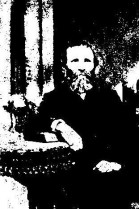 So this takes up just about up to the time when we believe that Ancil came to central Texas from Navarro County, Texas with his father Soloman after the death of his mother, Susanna Marvina Sifford. Soloman and his family lived in a couple of places before ending up in what is now Wilson County. First they lived in a settlement just north of San Antonio near the springs in the San Antonio River. Later they moved near Calavaras Creek, which is south east of San Antonio. On the 1850 Census taken in Bexar County, Calavaras Creek, Ancil is shown living with his father Soloman, his siblings Melissa, Nathan, and Aaron. The youngest sister, Dilla was not reported on this census so we have to assume that she died either in Navarro County before Ancil left with the other children or just after the family arrived in Bexar County. Along with his siblings, we also find two young boys, Joshua George and Jenkins “Jackson” Sifford. Soloman gave their names as Jackson to the census taker. Since the youngest was not born until 1847 we have to assume the Jackson family moved to Bexar County between 1947 and 1850.
So this takes up just about up to the time when we believe that Ancil came to central Texas from Navarro County, Texas with his father Soloman after the death of his mother, Susanna Marvina Sifford. Soloman and his family lived in a couple of places before ending up in what is now Wilson County. First they lived in a settlement just north of San Antonio near the springs in the San Antonio River. Later they moved near Calavaras Creek, which is south east of San Antonio. On the 1850 Census taken in Bexar County, Calavaras Creek, Ancil is shown living with his father Soloman, his siblings Melissa, Nathan, and Aaron. The youngest sister, Dilla was not reported on this census so we have to assume that she died either in Navarro County before Ancil left with the other children or just after the family arrived in Bexar County. Along with his siblings, we also find two young boys, Joshua George and Jenkins “Jackson” Sifford. Soloman gave their names as Jackson to the census taker. Since the youngest was not born until 1847 we have to assume the Jackson family moved to Bexar County between 1947 and 1850.
Keep in mind that in 1850, Texas had been a state for only 5 years. The Battle of the Alamo had been fought on March 6, 1836 only 14 years earlier and independence from Mexico had only been won on April 21, 1836. The Mexican American War had just ended and Mexico had just officially recognized Texas in the Treaty of Guadalupe Hidalgo on February 2, 1848. Times in Texas were difficult in those days from years and years of fighting with Mexico and the Indians.
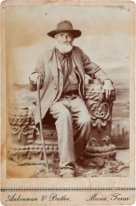 As it turns out, Solomon Jackson and his boys started building a cabin on the Cibolo right next to the land of famous Texas Ranger, Creed Taylor. Before the cabin could be finished, Soloman died of cholera on July 8, 1852 and was buried there in an unmarked grave. Dr. Thomas Meredith Batte, a wealthy man from Mississippi tried to save Soloman, but a cure for cholera was not known in those days. Creed Taylor opened his home to the young orphans and along with Dr. Batte was a significant influence on the boys’ lives.
As it turns out, Solomon Jackson and his boys started building a cabin on the Cibolo right next to the land of famous Texas Ranger, Creed Taylor. Before the cabin could be finished, Soloman died of cholera on July 8, 1852 and was buried there in an unmarked grave. Dr. Thomas Meredith Batte, a wealthy man from Mississippi tried to save Soloman, but a cure for cholera was not known in those days. Creed Taylor opened his home to the young orphans and along with Dr. Batte was a significant influence on the boys’ lives.
Creed Taylor was involved in almost every aspect of early Texas fight for independence. 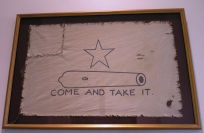 At age 15 he was in Gonzales going to school and witnessed the famous “Come and Take It” cannon incident that touched off the Texas revolution. Creed must have joined up with the Texas Rangers sometime before 1836. At that time they were generally referred to as Ranging Companies. He was in Captain John J. Tumlinson’s company when the Alamo was stormed and set out immediately to join Sam Houston and fought in the Battle of San Jacinto in 1836. When the Mexicans invaded Texas again in 1842, Creed was in San Antonio at the time of the fight and was wounded in the elbow. The musket ball wound bothered him for years. Creed went on to fight under Ranger Captain, Jack Hayes in the Mexican American War in 1846-1848. According to Jack Jackson’s book, when Creed Taylor returned home after the Mexican War, he was active in organizing militia groups to pursue Indian raiders in the area around Sutherland Springs.
At age 15 he was in Gonzales going to school and witnessed the famous “Come and Take It” cannon incident that touched off the Texas revolution. Creed must have joined up with the Texas Rangers sometime before 1836. At that time they were generally referred to as Ranging Companies. He was in Captain John J. Tumlinson’s company when the Alamo was stormed and set out immediately to join Sam Houston and fought in the Battle of San Jacinto in 1836. When the Mexicans invaded Texas again in 1842, Creed was in San Antonio at the time of the fight and was wounded in the elbow. The musket ball wound bothered him for years. Creed went on to fight under Ranger Captain, Jack Hayes in the Mexican American War in 1846-1848. According to Jack Jackson’s book, when Creed Taylor returned home after the Mexican War, he was active in organizing militia groups to pursue Indian raiders in the area around Sutherland Springs.
With a neighbor and benefactor like Creed Taylor it is only natural that Ancil would join Creed when times required the services of man who could ride and shoot. No doubt Ancil and perhaps even his younger brother Nathan would take up arms when needed. Ancil bought 200 acres of land on the Ecleto about four miles southeast of present day Stockdale in 1853 at the age of 23. He paid $100 which was a huge sum in those days.
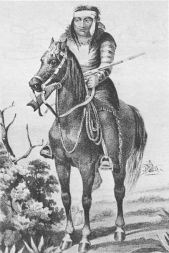 During the period from 1853-1857 there were continual requests from citizens in Bexar and Comal counties to the Governor, Elisha Pease to send in the Rangers to protect the citizens from Indian raids. This is likely the reason that in December 1854, Ancil formally enlisted in Company C of the Mounted Volunteers as a Private. He would have been only 22 years old at the time. The Mounted Volunteers were Rangers that were attached to the Regular U.S. Army. He formally served until March 14, 1855 a period of three months. Our best guess is that this service was in response to Lipan Apache and Kickapoo Indian Raids in the area. Ancil’s muster roll indicates he was reporting to Captain William R. Henry out of San Antonio.
During the period from 1853-1857 there were continual requests from citizens in Bexar and Comal counties to the Governor, Elisha Pease to send in the Rangers to protect the citizens from Indian raids. This is likely the reason that in December 1854, Ancil formally enlisted in Company C of the Mounted Volunteers as a Private. He would have been only 22 years old at the time. The Mounted Volunteers were Rangers that were attached to the Regular U.S. Army. He formally served until March 14, 1855 a period of three months. Our best guess is that this service was in response to Lipan Apache and Kickapoo Indian Raids in the area. Ancil’s muster roll indicates he was reporting to Captain William R. Henry out of San Antonio.
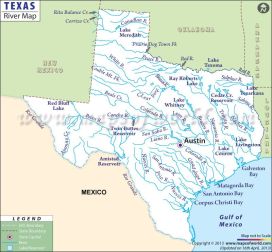 It is reported that in 1855, the Lipan and Kikapoo Indians were raiding in this area and had struck in La Vernia which is very close to Sutherland Springs. Word of the raids was sent to Seguin where Ranger Captain Henry McCulloch raised 28 volunteers to pursue the Indians. It is very likely that both Creed Taylor as well as Ancil Jackson were among those volunteers. They followed the raiders nearly to the Frio River before giving up the chase. As was very common in those times, if the Indians were pursued by the Rangers, they would flee across the Rio Grande to Mexico. Since Ranger companies were attached to the U.S. Army they had to stop at the border.
It is reported that in 1855, the Lipan and Kikapoo Indians were raiding in this area and had struck in La Vernia which is very close to Sutherland Springs. Word of the raids was sent to Seguin where Ranger Captain Henry McCulloch raised 28 volunteers to pursue the Indians. It is very likely that both Creed Taylor as well as Ancil Jackson were among those volunteers. They followed the raiders nearly to the Frio River before giving up the chase. As was very common in those times, if the Indians were pursued by the Rangers, they would flee across the Rio Grande to Mexico. Since Ranger companies were attached to the U.S. Army they had to stop at the border.
On July 5, 1855, as a result of continual Indian raids, the Governor authorized James H. Callahan to form a Ranger company to protect Bexar and Comal counties from the Indians. Captain Callahan enlisted 111 men to be paid by the Texas Legislature. For several months the company provided protection to the citizens in Bexar and Comal counties. In September of that year, Callahan led a group of Rangers on an expedition that ended up crossing the Rio Grande in pursuit of a group of Lipan Apaches. They went over 20 miles into Mexico before they caught up with the Indians and a group of Mexican troops. There were deaths and wounded on both sides and the Rangers retreated to Piedras Negras where they set the town on fire to cover their escape. The Governor forgave Callahan since the Mexican troops sided with the Indians in the fight. Some historians believe that the foray into Mexico was really an attempt to recapture runaway slaves who fled to Mexico and freedom when they escaped their owners.
So was Ancil and Creed a part of this effort. We have no way of knowing for sure since Ancil was supposed to be discharged from the Rangers during this event. However, Ancil’s Commanding Officer during his official service was Ranger Captain William R. Henry who was based in San Antonio at the time. Captain Henry was one of the principle instigators of the Mexico expedition in 1855. It would not be surprising if Ancil was one of the men who participated in this expedition. However Ancil had a lot of other responsibilities.
Between 1850 and 1860, Ancil was taking care of his orhpaned siblings. In 1860 he still had his brothers Nathan and Aaron living with him in addition to his sister, Melissa, and her new husband and daughter. The Sifford boys Joshua and Jenkins were there as well. It is likely that Ancil needed to focus on raising his family. However, as a result of his Ranger Service and his commitment to raising his siblings, Ancil was a well respected and trusted member of the little community. Those characteristics along with his ability to ride and shoot gained as a Ranger allowed his to serve as a courier for the local community in delivering their bank deposits on horseback to San Antonio.
You can read more about Ancil’s life in my blog, “Taming the Texas Frontier”, July 2012.
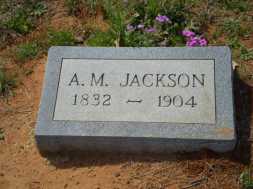 So does Ancil McDonald Jackson deserve a Ranger Cross on his grave? I say absolutely “Yes”. We are very fortunate that we have that one single Muster Roll proving his service to the Rangers. I am certain, that there were hundreds of other men in Central Texas during these tummulous years who defended their homes, families, crops, and livestock from the raiding Indian tribes just as Ancil did. Unfortunately we do not have records of their service so they can be honored as well. So let the Ranger Cross be for Ancil and for all of those other Texas heroes who we cannot honor. As Creed Taylor called these men, they were “Tall Men with Long Rifles” and their determination and bravery made the great state we now call Texas.
So does Ancil McDonald Jackson deserve a Ranger Cross on his grave? I say absolutely “Yes”. We are very fortunate that we have that one single Muster Roll proving his service to the Rangers. I am certain, that there were hundreds of other men in Central Texas during these tummulous years who defended their homes, families, crops, and livestock from the raiding Indian tribes just as Ancil did. Unfortunately we do not have records of their service so they can be honored as well. So let the Ranger Cross be for Ancil and for all of those other Texas heroes who we cannot honor. As Creed Taylor called these men, they were “Tall Men with Long Rifles” and their determination and bravery made the great state we now call Texas.
- Posted in: American Mexican War 1846-1848 ♦ Battle of San Jacinto ♦ Battle of the Alamo ♦ Former Texas Ranger Association ♦ Mounted Volunteers ♦ Regulators and Moderators War ♦ Republic of Texas ♦ Run-Away Scrape ♦ San Antonio ♦ Stockdale ♦ Sutherland Springs ♦ Texas ♦ Texas Ranger Cross ♦ Texas Rangers ♦ Texas Revolution
- Tagged: Aaron Jackson, Ancil McDonald Jackson, Captain Henry McCulloch, Captain Jack Hays, Captain John J. Tumlinson, Creed Taylor, Dr. Thomas Batte, James H. Callahan, Jenkins Sifford, Joshua George Sifford, Melissa Jackson Myers, Mirabeau Lamar, Nathan Jackson, Sam Houston, Solomon B Jackson, Susana Marniva Jackson, William R. Henry
I have a story about Ancil Jackson
I would like to share an interesting story about Ancil Jackson. I had cousins 20 years my senior. And this story was told by Aunt
Mattie.
Ancil loved horse racing. So much that he bet on these races. He was not living on the Jackson Ranch.
Ellinor Temperance ( his second wife and Aunt Mattie’s mother Almost got a divorce from Ancil. He gambled so much that the Jackson Ranch was in danger of being
forfeited .
Ancil came to his senses. He went home to the Jackson Ranch. Totally ashamed.
Aunt Mattie still lived on the Jackson Ranch.
Ellinor Temperance let him come home.
But…..Aunt Mattie made him sleep in the
Chicken Coop.
I’m 99% sure the story is true. Because everyone knew about it.
I didn’t want to put this up on the blog until I checked with you.
Ancil had a midlife crisis.
Thank you for all your hard work!
Thanks Laura,
I knew that he and Tempy were separated for a while. I did not know whether or not they got divorced. They apparently never exactly got together again as when you visit the Stockdale Cemetery, you will see Ancil buried in one place and Tempy in another. His first wife Seletia Ann West was buried with her parents and the other Wests in the Steele Branch Cemetery. This is a very good story. I had never heard the Chicken Coop story. I knew that he raised very fine horses and one of the reasons that he joined the Rangers to track down the Indians was that they were always trying to steal his horses.
I love hearing these stories. I grew up a Sutherland rather than a Jackson and never lived in the Wilson County area. We lived in Cuero and later in San Antonio. I had an Uncle Garvey Odom and Aunt Bessie Cox Odom that I visited a lot as a child. They lived out on a farm between Stockdale and Floresville where they raised peanuts and watermelons.
Sharon